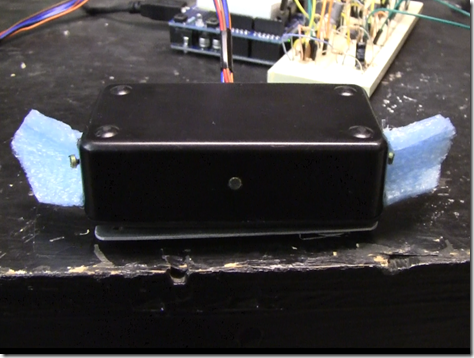I searched for days trying to find a commercial sound localization sensor or info on how to build one. Sound localization is what the human ear does when it determines that a sound is coming from the left or right. After talking to some gentlemen over at the Arduino forums I realized that it wasn’t going to be as simple as I thought.
I finally hacked together something that works great for my first try, there is a lot of work to be done though. The sensor works fairly well from a foot or so away, after that you really feel the limitations of my circuit and only doing a volume comparison from the microphones.
Here are the related project files. Sketch Audio_Localization and schematic SoundLocalization
I am aware that the LM324N is not specifically a comparator but can work as one, it seems to do the job.
If you are interested there are some videos on YouTube regarding sound localization but they only demonstrate the sensors and give no helpful information on building one yourself.
I may in the future try to use an ARM Cortex M3 proto board I purchased from Texas Instruments (EKK-LM3S811 Evaluation Kit) to do phase shift comparison calculations for sound localization, the Arduino is nowhere near fast enough to do this. After reading some information I believe you need to be able to sample and do a calculation in 10-50 micro seconds in order to get usable data.


hey man !
the Audio_Localization_Sketch.zip there is the type of file PDE where i can the file . is it program or what.
thanks
The pde is opened with the free Arduino IDE. You can download it at http://arduino.cc/
All of the actual sound localization was done with the circuit, the Arduino sketch just turned the head of the sensor.
hi there….your pde program seems different with video?
also the circuit is complete or not? I want to try build it…
That is the circuit you see in the video, it works.
are sure? the program does not work. Could you email me please.
I am an ass, the sketch was the wrong one. I have updated the sketch with the proper one. Please note that all the sketch does is watches two pins and will turn the servo left or right depending on the signals coming in from the comparator circuit. Essentially all the magic happens in the circuit and not the Arduino sketch.
hi. thanks for a lot of info regarding sound localization. May i know from where i can download the updated sketch plz…
Hey,
I thought this was pretty interesting and tried one for myself, however it doesn’t seem to work. I know it has to do with my circuit (possibly an issue with the signal from the mic not getting to the circuit). Would you have any idea what/how I could troubleshoot to figure out whats wrong?
Unfortunately, when you are working with audio its hard to troubleshoot without an oscilloscope. I know that was an essential tool for me. I had a lot of trouble with the microphones and getting them connected properly.
ah.. i tried a lot with the files u hav provided.. i couldn’t succeed..
Hi admin, this is a great project. I am trying to build a similar thing. In my project i want to include a filter and use just two mics, will keep you posted on how it goes. Good job